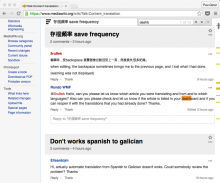In some conversations it was brought up an advanced scenario where users may want to launch a separate search to complement the current context.
To support that scenario it may be useful to open the links in a new browser tab:
- An icon to open the current search results is shown when the focus is on the search field or when the user hovers on it.
- When the user clicks the icon, a new page is open with the same search, and the original page returns to the previous context where it was before.
With the above approach, user that is reading a topic X but need to search for information about Y and Z, will be able to open the searches for Y, Z and more in new tabs and preserve the context of topic X once the user closes the other tabs.
This is just an initial exploration. More information on such scenarios may be needed to iterate and test the above idea. So anyone familiar with those feel free to add details.

